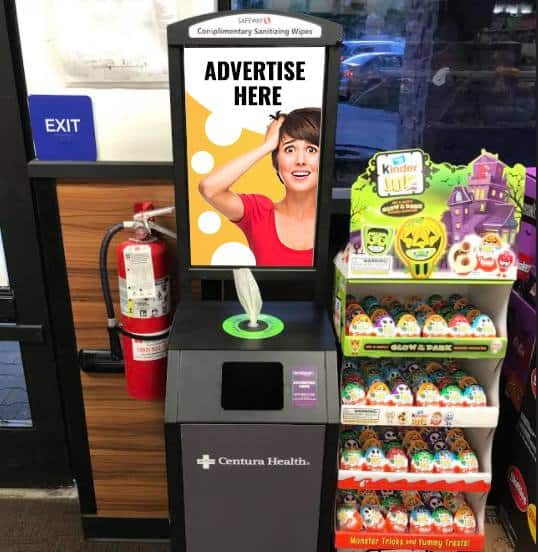Indoor Advertising with Sanitizing Stations: Smarter Campaigns Through QR Code Personalization
Indoor advertising with sanitizing stations has emerged as a high-visibility, high-trust format in the post-COVID media landscape. From hospitals and gyms to retail lobbies and airports, these touchpoints offer a rare combination of utility, hygiene relevance, and dwell time.
But if your campaign ends at a static visual—you’re missing its true potential.
The future of Sanitizing Stations advertising lies in QR code personalization. By segmenting your campaign through dynamic QR experiences, you can build microfunnels tailored to audience behavior, location, and intent—turning passive hygiene moments into actionable brand engagements.
In this blog, we’ll explore how marketing professionals can use personalized QR codes on Sanitizing Stations ads to build smarter, segmented campaigns that outperform static formats.
Indoor Advertising with Sanitizing Stations: Why QR Codes Matter Now
Let’s start with the basics: Why are QR codes so critical to Sanitizing Stations advertising?
They bridge offline-to-online engagement
Your Sanitizing Stations ad gets attention. But without an action, it’s just a brand impression. QR codes drive users to:
Sign up
Download
Learn more
Purchase
Join a loyalty program
They offer trackability
Each scan becomes a data point: location, time, engagement rate. That’s gold for marketers wanting attribution from physical media.
They enable real-time personalization
Using dynamic QR codes, you can tailor the destination URL based on:
Kiosk location (e.g., gym vs. retail store)
Time of day
Language or demographics
Campaign phase or promotion window
Creating Microfunnels with Sanitizing Stations Ads
The real magic happens when QR codes aren’t just generic links—but are strategically segmented to match audience intent.
Let’s break it down:
Step 1: Segment by Location
A QR code on a sanitizing kiosk in a hospital should drive to a different landing page than one in a shopping mall.
Hospital: Offer health-related content, insurance quotes, or appointment booking.
Retail: Drive product promos, loyalty app installs, or e-commerce offers.
Gym: Offer fitness challenges, supplement deals, or hydration trackers.
This segmentation ensures that your Sanitizing Stations ad speaks to the moment and the setting.
Step 2: Segment by Time
Morning commuters in office buildings may respond to productivity content or finance tools. Evening shoppers may prefer meal kit offers or relaxation apps.
Dynamic QR codes let you rotate offers based on time slots, creating time-sensitive microfunnels.
Step 3: Segment by Audience Demographics
If the sanitizing station is placed in a pediatric clinic, the QR code could drive parents to child-specific resources. In a college dorm lobby? Push student discounts or career tools.
Contextual relevance = higher conversion.
Indoor Advertising with Sanitizing Stations: Attribution and Analytics
One of the biggest advantages of QR-powered Sanitizing Stations advertising is that it unlocks clear attribution paths—a rare feat for physical media.
What you can track:
Total scans per location
Conversion rates per funnel
Time-on-page and bounce rate from different environments
Device type, OS, and even returning users
This allows you to:
A/B test creative by location
Validate messaging performance in real-world settings
Justify campaign ROI with performance data
And all of this from what used to be considered just “awareness media.”
Case Example: QR Microfunnel Strategy in Action
A national wellness brand launched a segmented campaign across Sanitizing Stations ads in 3 environments:
Retail stores
Fitness centers
Urgent care clinics
Each QR code was tied to a custom funnel:
Retail: Instant 10% coupon and product landing page
Fitness: “Join Our Hydration Challenge” with SMS opt-in
Clinics: “Check Symptoms, Book a Virtual Visit” CTA
Results over 4 weeks:
Total scans: 8,600
Conversion rate: 22.5% (1,935 completed actions)
Highest performing segment: Fitness centers (33% opt-in rate)
Cost per acquisition: $2.61
Without QR personalization, these numbers would be invisible—and likely far lower.
The UX of Sanitizing Stations QR Campaigns
A critical element of marketing with sanitizing stations is optimizing the user experience after the scan. A weak landing page can sink even the most targeted ad.
Best practices:
Keep pages mobile-first
Load fast (under 3 seconds)
Use single CTA per page
Minimize form fields
Offer instant value (coupon, content, confirmation)
You’ve already captured the user’s attention with a useful, trusted moment. Don’t lose them with a bad funnel.
QR Codes + Sanitizing Stations = Agile Campaign Strategy
Another overlooked benefit of using QR codes in Sanitizing Stations advertisement is agility.
You can:
Swap promotions instantly without changing the physical kiosk
Test multiple CTAs with the same creative
Pause underperforming funnels in real time
Localize languages by venue
This means your campaign can evolve, optimize, and even shift messaging—without new prints, placements, or added media spend.
Future Opportunities: Combining Sanitizing Stations with Programmatic DOOH
Looking ahead, the next evolution of Indoor Advertising with Sanitizing Stations may come from combining:
Dynamic QR codes
DOOH screen personalization
Foot traffic + scan attribution
Integration with loyalty programs and mobile apps






